Paving the way forward: What’s new in road construction?
27 March 2023
Ambitious road projects are ongoing across Europe – connecting communities and creating smooth transitions from one country to another. Catrin Jones looks at what’s new in the industry.
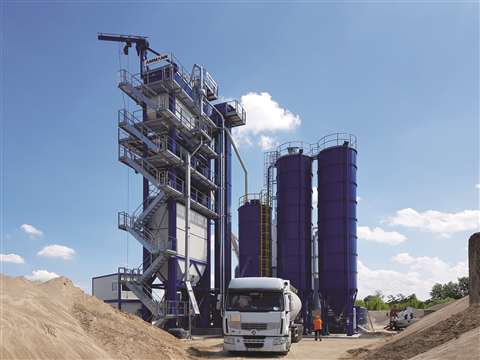 UniBatch used by Trakt in Poland (Photo: Ammann)
UniBatch used by Trakt in Poland (Photo: Ammann)
There is no doubt that roads are among the most important pieces of infrastructure in the world. To keep up with the billions of people using one of the world’s oldest industrial advancements to commute to work or cross national borders, the equipment and technology used to build roads must be able to meet the demand.
Construction Intelligence Centre (CIC) is currently tracking road-related construction projects in Europe with a total value of €448 billion – €182.8 billion is said to be in the execution stage and €152.5 billion is in the planning stage. Russia accounts for the highest value with €61 billion, followed by the UK with projects valuing €59.8 billion.
Crucial transport connections
Balfour Beatty recently announced that they have been awarded a huge roadbuilding contract within the UK’s Lower Thames Crossing project.
The deal, worth approximately €1.37 billion, will see the company construct more than 16km of roads to the north of the proposed river crossing, including a crucial connection with the M25 motorway that runs around London.
The scope of the contract, awarded by the UK’s National Highways agency, also includes the construction of 49 structures, including bridges and viaducts, many of which will be built offsite, using modular construction techniques.
Over in Norway, several major roadbuilding projects are nearing completion. The Trysfjord Bridge has been a ground-breaking engineering project that has seen the boundaries of digital engineering pushed to their limits.
Consultants Norconsult says that through close collaboration between contractors and advisers, they have been able to reduce the concrete footprint by over 18% from previous solutions for the crossing.
The Trysfjord Bridge is said to stretch the limits of what is possible to build as a free-forward bridge, with its fjord span of 260 metres, especially since the bridge is being built with four carriageways and a total width of 24 metres.
Improving efficiency in roadbuilding in Europe
With an increase in projects across the continent, companies are looking for ways to improve efficiency and get more done with the same amount of time and workers – so could attachments be a solution to this problem?
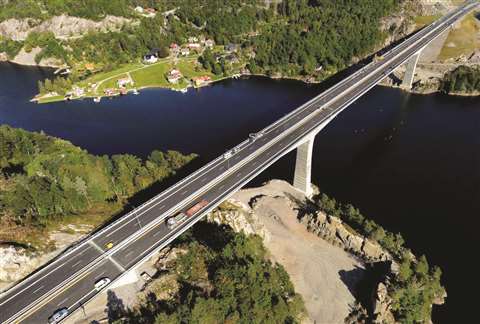 Trysfjord Bridge project in Norway
Trysfjord Bridge project in Norway
Lynn Marsh, president of Roadwidener, believes that they can. “Attachments provide a realistic, effective solution by utilising equipment that contractors are already familiar with. By changing workflow, minimising maintenance, lowering equipment cost, allowing for smarter labour and increasing Return on Investment [ROI]”.
Road construction tasks like backfilling and aggregate placement are typically considered four-step processes. Marsh thinks that the way to increase efficiency and safety is to minimise the number of steps in the process with the use of material placement attachments.
She adds, “Crews can do more work in a day and do more with their budget by cutting out steps without adding more self-propelled machines or workers. And those savings continue with a drastically lower cost of ownership when compared to self-propelled machines.”
Attachments are just one solution to the growing demand for road infrastructure projects. OEMs are also ensuring that they can simplify the process with advances in electric equipment.
Set to debut at North America’s largest construction trade show ConExpo-Con/Agg 2023, Volvo Construction Equipment’s (Volvo CE) DD25 Electric asphalt compactor is the company’s first electric machine produced specifically for the company’s road segment.
Upgraded compactors for road construction
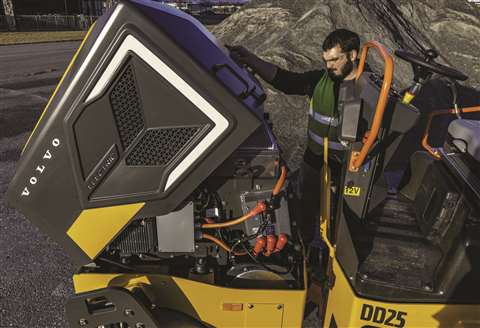
Volvo CE designed the compact double-drum compactor for small-scale compaction projects including street repairs and patching, parking lots, driveways, municipalities and rental houses.
Dr Ray Gallant, vice president of Product Management and Productivity at Region Americas, Volvo CE, said that after the DD25 Electric’s introduction at ConExpo, the company expects to take orders for the compactor later in 2023, with deliveries in the first quarter of 2024.
The machine will initially be available in North America, with other markets hoping to follow later.
Like Volvo CE, Wirtgen Group-owned Hamm has introduced the HX series, with the company calling it a new generation of pivot-steered tandem rollers.
Replacing the previous DV+ series, Hamm says it has an intuitive operation with Easy Drive, high-performance data, comfort features and sustainable operation, as well as the ‘Smart Compact’ digital compaction assistant. All models are available in countries with the EPA Tier 4/EU Stage V emissions regulation.
A foundation for high compaction quality is intelligent drive control with automatic reversing. Hamm says that this, in combination with the electrically adjustable seat operating unit, “guarantees quality and comfort.”
The seat turns automatically in the direction of travel when reversing, which is said to be unique in the market.
The Smart Compact compaction assistant can be used in the rollers of the HX series. The system decides compaction automatically and individually for each drum: whether to compact with vibration and big or small amplitude, with oscillation, or statically. The driver only has to enter whether a base, binder or asphalt surface course is to be compacted.
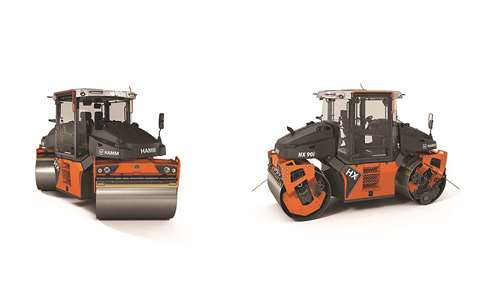 Hamm HX Series (Photo: Hamm)
Hamm HX Series (Photo: Hamm)
Hamm says that it is the first manufacturer in the world to automate the separate setting of both drums and is raising the compaction and surface process reliability and quality.
Mixing plants for regional projects
Equipment manufacturers are adapting their technology at great speed but also integral to any road project is the asphalt mixing plant.
Poland-based company Trakt has played a key role in the country’s roadbuilding projects. The company recently purchased an Ammann ABA 210 UniBatch Asphalt-Mixing Plant to ensure that they can take on any task.
Established in 1991, Trakt has built a solid reputation among road companies in Poland’s northeast region. It specialises in the construction and modernisation of roads, streets, bridges, sewage systems and engineering structures – and above all in the production of varied bituminous mixes.
“We were involved in the construction of access roads to our region,” says Jerzy Szklaruk, President of Trakt. “There were lots of municipal roads, which required us to produce between three and five different types of mixes every day.”
The company says that adjusting between the mix types was not a problem due to the benefits given to them by the Ammann ABA UnitBatch.
Accelerated production
A key driver behind purchasing a new plant was its 210 tonnes per hour capacity. The previous plants produced a mix of 80 tonnes per hour – which was typically enough for Trakt’s projects.
“But there are days or recipes where you need to accelerate to 210 tonnes per hour, and thanks to the ABA UniBatch we are prepared for it,” Szklaruk added. “With large contracts, the performance of the plant translates into a real margin for the entire project. In three days, we can accomplish what takes others a week.”
Trakt purchased its ABA 210 UniBatch with a cold recycling system and a BKS coal dust burner. It has plans to add asphalt foaming capability as well.
“We equipped the plant with recycling components, but only with the future in mind. Relatively little RAP is used in our region. But whenever there is a project using RAP, we are more competitive.”
While the RAP usage may be low, that is already changing – and the percentage will continue to grow, says Szklaruk.
Environmental goals in construction
In the meantime, the company says that being as sustainable as it can is a priority. Ammann’s filtration system coupled with
the plant’s ability to suppress sound via ribbed sheets in the discharge channels to reduce sound is said to be in line with the company’s wider environmental goals.
Sustainability is something we are talking about more and more frequently, so it comes as no surprise that the roadbuilding equipment industry is working diligently to meet our environmental targets.
Many companies are currently working towards increasing efficiencies throughout projects whilst ensuring the equipment is as sustainable as it can be. This year will see even more roadbuilding projects – some even more ambitious than before – and a continued ease of movement across the continent.
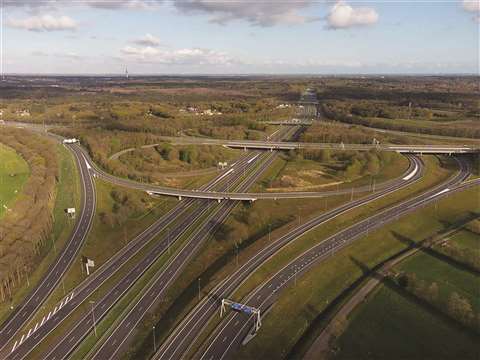
US-based contractor Fluor and its Dutch joint venture (JV) partner Ballast Nedam have been awarded a contract to design, build and maintain a major section of the A27 motorway in the Netherlands.
Fluor’s share of the contract will total approximately €414 million.
The JV team will widen approximately 40km of the existing motorway and extend it to form a future connection to the proposed Groote Haar business park in Gorinchem.
Within the scope of the contract, the team will also replace two motorway bridges and carry out repairs to the Hooipolder junction.
The contract, awarded by the Netherlands’ Ministry for Public Works and Water Management (Rijkswaterstaat), has a two-phase approach, with the project owners preparing the detailed design of the second phase, once the first phase of construction is underway.
Rijkswaterstaat and its development partner ALSÉÉN anticipate this leading to a more refined scope of work and a more predictable second phase for the project, as it will allow for more accurate site investigations and work packaging, plus more clarity in subcontract negotiations.
Shawn West, president of Fluor’s Infrastructure business, said, “Fluor has more than 20 years of experience designing, building and maintaining sustainable infrastructure projects in the Netherlands.
“This is the first project in the region to use a new two-phase approach between the joint venture and Rijkswaterstaat to limit project risks. We expect this unique approach to result in better project outcomes and a more stable execution phase for all parties.”
Construction on the motorway is scheduled to begin later this year, with completion expected between 2029 and 2031.
Trimble has announced that the Norwegian Public Roads Administration (NPRA) Operations and Maintenance has selected its AgileAssets infrastructure enterprise asset management software to manage, maintain and operate the country’s 10,600-km road network and associated transportation infrastructure.
The NPRA is reported to already be using Trimble’s Quadri software, a cloud-based Building Information Modeling (BIM) collaboration solution that is used for construction projects.
Additionally, the NPRA believes that Trimble’s Quadri and AgileAssets will enable them to meet growing demands by leveraging connected data to improve performance throughout the entire asset lifecycle, from design and construction to operations and maintenance.
“Delivering safe, cost-effective and sustainable transportation infrastructure increasingly depends on closing the data gap between construction, maintenance and operations,” said Shelly Nooner, vice president of Innovation and Platform in Trimble’s Owner and Public Sector.
“Today, design data is as important during maintenance as it is during construction. As infrastructure needs increase in size and complexity, and data continues to accumulate through an asset’s lifecycle, the ability to share, analyse and build on that data at every stage will be transformative.”






